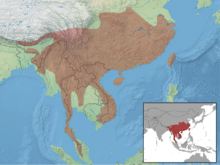Pallas's squirrel
| Pallas's squirrel | |
|---|---|
| | |
| Scientific classification | |
| Kingdom: | Animalia |
| Phylum: | Chordata |
| Class: | Mammalia |
| Order: | Rodentia |
| Family: | Sciuridae |
| Genus: | Callosciurus |
| Species: | C. erythraeus |
| Binomial name | |
| Callosciurus erythraeus (Pallas, 1779) | |
| Subspecies | |
|
About 30; see text | |
 | |
| Synonyms | |
|
Callosciurus flavimanus | |
Pallas's squirrel (Callosciurus erythraeus), also known as the red-bellied tree squirrel, is a species of squirrel native to Greater China, India, and Southeast Asia.
Description
Pallas's squirrel is a medium-sized tree squirrel, with a head-body length of 16 to 28 cm (6.3 to 11.0 in), and a tail 11 to 26 cm (4.3 to 10.2 in) in length. Both sexes are of similar size and appearance, and weigh between 310 and 460 g (11 and 16 oz). The colour of the pelt varies considerably between the many different subspecies, but is generally brownish on the upper body with a more reddish tint on the belly, and often with some black on the tail. The precise pattern and shades of the fur are often used to distinguish subspecies from one another, but make it difficult to distinguish the species as a whole from other, similarly variable, tree squirrel species.[2]
Subspecies
Over 30 subspecies have been identified, although not all are recognised by all authorities:[2]
|
|
|
|
Distribution and habitat
Pallas's squirrel is found throughout much of southeastern Asia, including far eastern India, Bhutan, northern and eastern Myanmar, Vietnam, parts of Cambodia and Laos, much of Thailand, northern peninsular Malaysia, southern and eastern China, including Hainan, and Taiwan. Within this region, they are found within a range of forest habitats below 3,000 m (9,800 ft) elevation, including tropical and subtropical evergreen,[3] deciduous broadleaf, and subalpine conifer woodlands.[1] Populations have been introduced in the Buenos Aires Province of Argentina, Belgium, Netherlands, France, and Japan.[2]
Biology
Like all tree squirrels, Pallas's squirrels are primarily herbivorous. They eat a wide range of different foods, and have differing diets in different parts of their broad range. However, primary foodstuffs include leaves, flowers, seeds, and fruit.[4] They also eat small quantities of insects, as well as occasional bird eggs.[2]
The squirrels breed throughout the year, and may mate again as soon as they have weaned a previous litter. Pregnancy lasts 47 to 49 days, and results in the birth of up to four young, with two being typical. The young leave the nest at 40 to 50 days old, and are sexually mature at one year of age. They have lived for up to 17 years in captivity.[2]
Behaviour
Pallas's squirrels are diurnal,[2] and inhabit much of the forest canopy, and construct both leaf nests 7 to 18 m (23 to 59 ft) above the ground, and, less commonly, underground burrows.[5] Females occupy home ranges of just 0.5 to 0.8 hectares (1.2 to 2.0 acres), which usually do not overlap, while males occupy much larger ranges of 1.3 to 3.8 ha (3.2 to 9.4 acres), which overlap with those of both nearby males and females.[6] Like many other squirrels, they have been observed to cache acorns in the autumn.[3]
The squirrels make calls to warn neighbours of predators, and have been observed to mob tree-climbing snakes, with females protecting young being particularly likely to join in.[7] Males also make loud calls prior to, and after, mating.[8]
References
| Wikimedia Commons has media related to Callosciurus erythraeus. |
- 1 2 Duckworth, J. W.; Timmins, R. J. & Molur, S. (2008). "Callosciurus erythraeus". IUCN Red List of Threatened Species. Version 2008. International Union for Conservation of Nature. Retrieved 6 January 2009.
- 1 2 3 4 5 6 Lurz, W.W.; et al. (2013). "Callosciurus erythraeus (Rodentia: Sciuridae)". Mammalian Species. 45 (902): 60–74. doi:10.1644/902.1.
- 1 2 Xiao, Z.; et al. (2009). "Behavioral adaptation of Pallas's squirrels to germination schedule and tannins in acorns". Behavioral Ecology. 20 (5): 1050–1055. doi:10.1093/beheco/arp096.
- ↑ Koyabu, D.B.; et al. (2009). "Craniodental mechanics and the feeding ecology of two sympatric callosciurine squirrels in Vietnam". Journal of Zoology. 279 (4): 372–380. doi:10.1111/j.1469-7998.2009.00629.x.
- ↑ Setoguchi, M. (1991). "Nest-site selection and nest-building behavior of red-bellied tree squirrels on Tomogashima Island, Japan". Journal of Mammalogy. 72 (1): 163–170. JSTOR 1381991. doi:10.2307/1381991.
- ↑ Tamura, N.; et al. (1988). "Dominance hierarchy and mating behavior of the Formosan squirrel, Callosciurus erythraeus thaiwanensis". Journal of Mammalogy. 69 (2): 320–331. JSTOR 1381382. doi:10.2307/1381382.
- ↑ Tamura, N. (1989). "Snake-directed mobbing by the Formosan squirrel Callosciurus erythraeus thaiwanensis". Behavioral Ecology and Sociobiology. 24 (3): 175–180. doi:10.1007/BF00292100.
- ↑ Tamura, N. (1995). "Postcopulatory mate guarding by vocalization in the Formosan squirrel". Behavioral Ecology and Sociobiology. 36 (6): 377–386. doi:10.1007/BF00177333.
